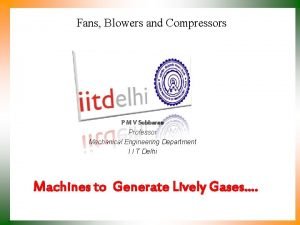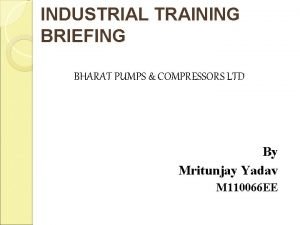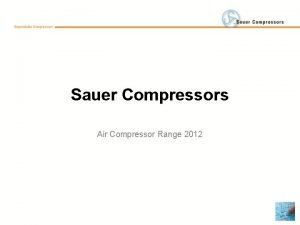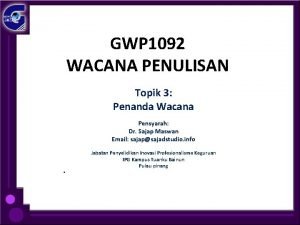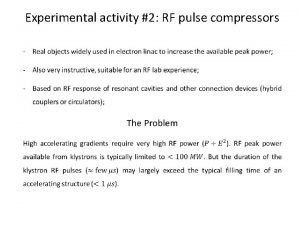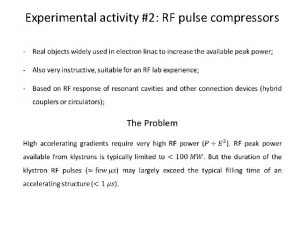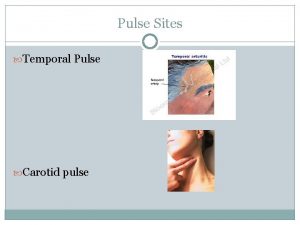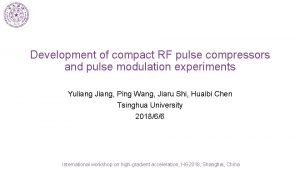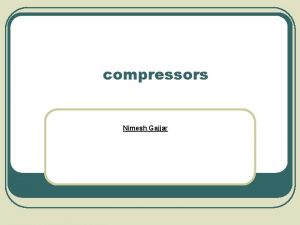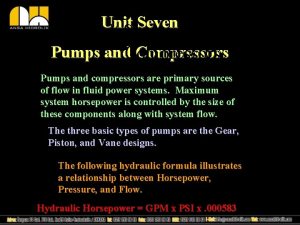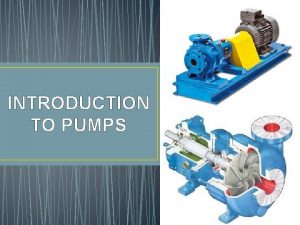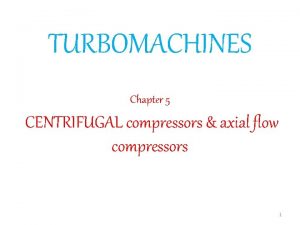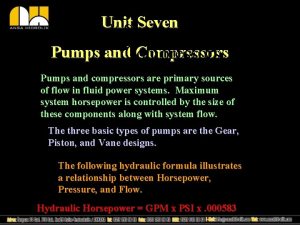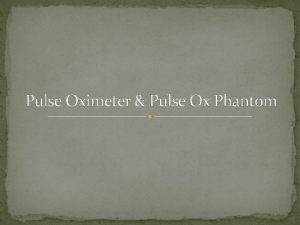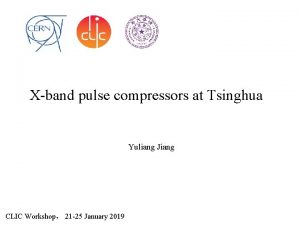Experimental activity 1 RF pulse compressors The Idea

















- Slides: 17

Experimental activity #1: RF pulse compressors

The Idea: SLED (Stanford Linac Energy Doubler) • The energy of the RF pulse is compressed in about 1 filling time to increase the peak power to the maximum! Klystron typical RF pulse 50 MW Compressed pulse 200 MW 4 µs • A factor 4 in power corresponds to a factor 2 in accelerating gradient, i. e. in beam energy!! • This idea has been implemented for the first time at SLAC in the 70’s [1] Q: How can a large RF power flowing in a waveguide be manipulated to be compressed? A: Compression is obtained capturing the RF power reflected by high-Q resonant cavities. [1] Farkas et al. - SLED A method of doubling SLAC energy

Recap: coupling coefficients of a resonant cavity The extra-power that flows out through the cavity couplers may significantly change the characteristics of the resonance. This effect is known as “cavity loading”. The loaded cavity Q-factor is lowered by the power coupled out through the cavity ports and results to be:

Wave reflection in a guide terminated on a resonant load • A resonant cavity is a non-matched load for a waveguide or a transmission line, and can be modeled as an RLC parallel circuit. • An RF wave travelling from the generator toward the cavity is always partially reflected at the cavity input. The reflected wave can be calculated according to:

Cavity reflected wave and input coupling coefficient Coupl. coeff. Lorentzian network transfer function What are we going to do in the following: 1. Calculate and plot the Lorentzian network response when VIN : 2. Calculate and plot the cavity reflected wave when VFWD : Step pulse Rectangular pulse

Lorentzian network response: RF step pulse The response of a Lorentzian network to an RF step pulse is: 1 Tstart

Lorentzian network response: RF rectangular pulse The response of a Lorentzian network to a RF rectangular pulse is: 1 Tstart Tend

RF step pulse reflected by a resonant cavity The reflected wave of a resonant cavity to an RF step pulse has the following transfer function: 1 Tstart In time domain: 180° phase inversion

RF pulse reflected by an over-coupled resonant cavity The wave reflected by an over-coupled cavity excited by a rectangular RF pulse is: 1 0 Tp The RFL peak field is maximum at the end of the FWD pulse (the negative step sums in phase with the reflected wave) -> its value is larger than the peak of the FWD itself.

RF pulse reflected by an over-coupled resonant cavity This effect can be enhanced by forcing a 180° phase jump in the driving pulse at a certain time (Ts) before the end of the pulse. Thus we induce an equivalent step in the driving signal of double amplitude which adds in phase with the signal originated by the first rising front of the driving RF pulse. Max theoretical amplitude gain = 3 1 0 -1 Ts Tp

How to route the power flow towards the accelerator (and not towards the klystrons…) Circulators are non-reciprocal (typically) 3 -ports 90° hybrids are non-reciprocal (typically) 4 -ports devices whose scattering matrix is ideally given by: 1 2 3 4

How to route the power flow towards the accelerator (and not towards the klystrons…) If we feed RF power from port 1 (klystron): • • • No power emerges from port 2 Half power emerges from port 3 (90° phase shift) Half power emerges from port 4 (in phase) S 21=0 S 31= j/√ 2 S 41= 1/√ 2 Reflected power from cavity 1: • • • No power emerges from port 4 Half emerges from port 1 with another 90° phase shift Half emerges from port 2 in phase S 43=0 S 13= j/√ 2 S 23= 1/√ 2 RF source (klystron) Accelerating structure Reflected power from cavity 2: • • • No power emerging from port 3 Half emerges from port 1 in phase Half emerges from port 2 with 90° phase shift Tot. power towards klystron (port 1): S 34=0 S 14= 1/√ 2 S 24= j/√ 2 -1/2 + 1/2 = 0 Tot. power towards accel. structure (port 2): j/2 + j/2 1 2 3 4 RF cavity 1 RF cavity 2

Experimental activity #1 Introduction: Measure environmental conditions and calculate SLED tuning frequency (working temperature Top = 40 °C, and nominal frequency f RF = 2856 MHz) Time domain: domain set-up of the RF pulse CW signal at f. LP from signal generator Stanford digital delay setup (5 us, 100 Hz, TTL High. Z) RF Switch setup 90° hybrid Oscilloscope cross-check Frequency domain: realization of the 180° phase jump Design of a 180° phase shifting circuit Functionality cross-check of the 180° phase shifter provided Input port Output port Actual phase shift measurement Generation and timing regulation of the trigger signals Oscilloscope cross check (30 d. B att. 500 m. V/div) Time domain: SLED tuning with rectangular input pulse (no 180° phase jump) Cavity n. 1 optimization Cavity n. 2 optimization Tuning optimizing SLED output Time domain: visualization of SLED output pulse with 180° phase jump Fine frequency tuning of the SLED pulse Qualitative measurement of energy/power gain Scan Tjump vs energy gain High Q cavities

Hint: SLED tuning

Hint: SLED tuning (finding f. LP)

Hint: SLED tuning (single cavities) • Connect the output waveguide to a matched load; • Set-up the RF pulse: • • CW signal at f. LP • Pulsed signal at f. LP (5 us length, 100 Hz rep. rate) Display the reflection signal from each cavity on an oscilloscope (use a flat pulse without phase reversal). The connections should look like the scheme below: Oscilloscope Screen • Rotate the tuning screw to tune the resonant frequency of the cavity to have a minimum (dashed line). Repeat the procedure a couple of times for fine tuning. • Check the input VSWR: it should not be higher than 1. 2

Hint: SLED tuning (sum of 2 cavities) Once the cavities are individually tuned, the output signal of the SLED (without phase jump) should look like this: Oscilloscope screen Rotate the tuning screw to fine-tune the SLED output If the cavities do not have the same response (different Q 0 or different β), the optimum might not be where one expects it…
 Fans blowers and compressors
Fans blowers and compressors Pump
Pump Fans blowers and compressors
Fans blowers and compressors Gardner denver blower georgia
Gardner denver blower georgia Bharat pumps & compressors ltd
Bharat pumps & compressors ltd Sauer compressors
Sauer compressors Experimental vs nonexperimental research
Experimental vs nonexperimental research Experimental vs non experimental
Experimental vs non experimental Nonexperimental study
Nonexperimental study Descriptive vs correlational vs experimental research
Descriptive vs correlational vs experimental research Disadvantages of experimental research
Disadvantages of experimental research Expository preaching vs. exegetical preaching
Expository preaching vs. exegetical preaching Penanda wacana upsr
Penanda wacana upsr Supporting idea
Supporting idea Suporting sentences
Suporting sentences Theme and topic difference
Theme and topic difference What does central idea mean
What does central idea mean What is implied main idea
What is implied main idea
